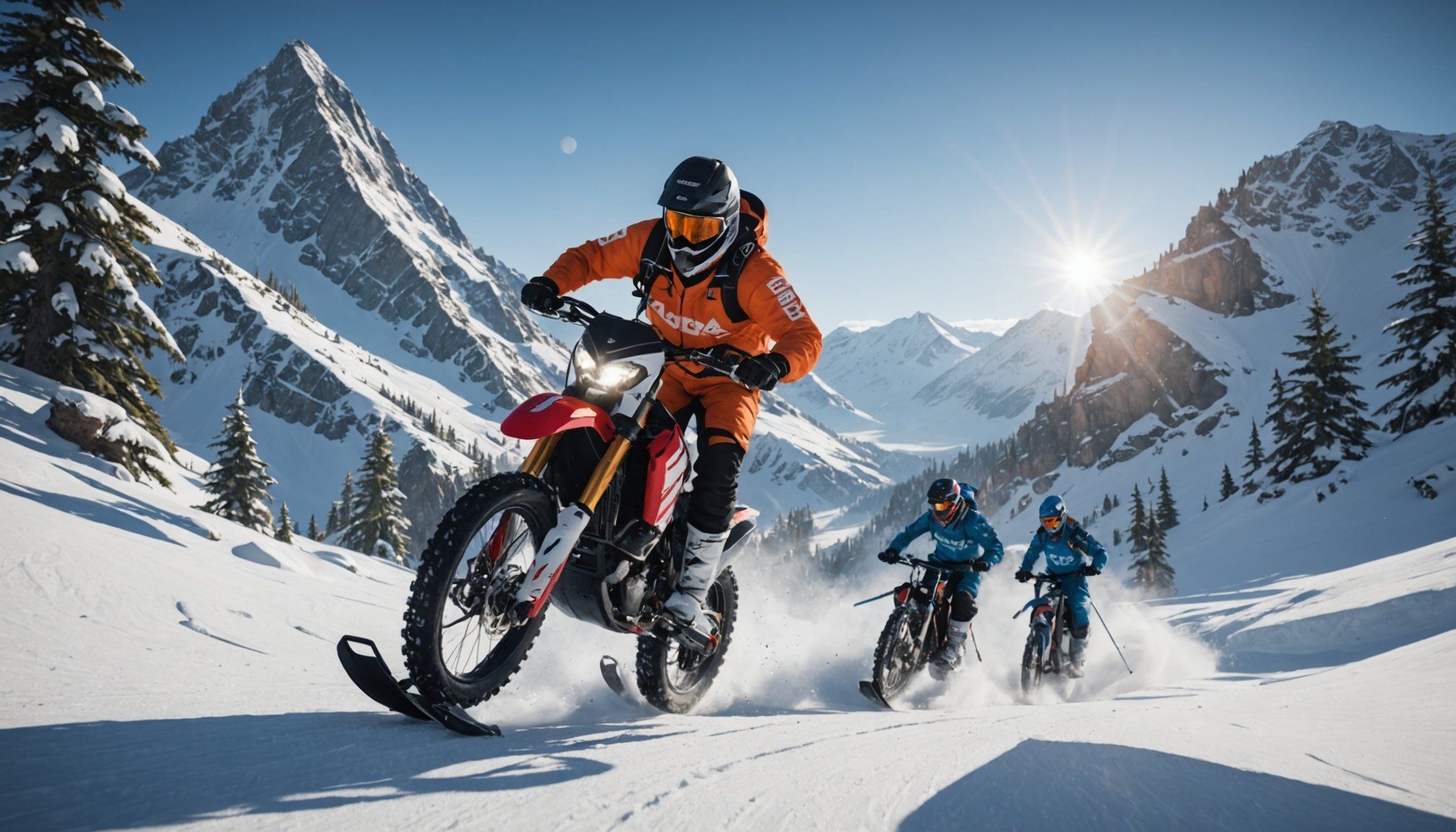Overview of Snow and Ice Physics in Game Development
The role of snow physics and ice physics in game development is indispensable, especially for creating immersive winter sports experiences. By simulating these natural phenomena with high fidelity, developers can significantly enhance gameplay realism and player engagement. Video games heavily rely on physics engines to model how snow and ice behave under various conditions, providing players with an authentic interaction experience.
One essential technique involves using algorithms that accurately replicate snow and ice properties. For instance, snow can be simulated through particle systems, enabling realistic snowflake and accumulation effects. This technique requires careful balance; while visually stunning snow effects can wow players, they also demand significant processing power. Hence, optimizing performance without sacrificing quality is crucial.
Additional reading : Mastering Stealth: Innovative Dynamic Lighting Techniques for a Truly Immersive Video Game Experience
Physics engines play a pivotal role by managing the complex calculations needed for realistic movements and interactions with snow and ice. In winter sports games, for example, they ensure that acceleration on icy surfaces feels natural, affecting how a snowboard slides down a slope or how an ice hockey puck glides across a rink. In essence, combining advanced algorithms with finely-tuned engines allows developers to craft engaging and believable snow and ice environments in their games.
Key Techniques for Implementing Snow Physics
Implementing snow simulation techniques in game development can significantly elevate the realism and immersion of winter sports. Among these techniques, snow particle systems are pivotal. They deploy numerous tiny particles to replicate snowflakes, effectively creating dynamic accumulation effects on various game terrains. Developers strive for a balance between visual fidelity and performance, ensuring real-time rendering without overburdening system resources.
Also to see : Navigating Challenges: Essential Obstacles in Crafting Cross-Platform Multiplayer Games
Snow Compression and Dynamics
Snow compression and dynamics are crucial in conveying authentic in-game experiences as players navigate snowy environments. Simulating snow compression involves calculating how surfaces compact under character or object weight, offering realistic feedback. Dynamic snow behavior that reacts to players’ actions can be enhanced through shaders, which visualize snow depth and texture variance.
Environmental Interaction with Snow
Creating convincing interactions, such as footprints and ski tracks, greatly impacts the player’s perception of snow quality. These changes are often determined by terrain and climatic conditions. Furthermore, simulating snow’s transition phases, like melting or hardening, remains challenging yet rewarding. Attention to these details can differentiate a game by adding layers of realism, ultimately enriching the player’s engagement in wintry settings.
Key Techniques for Implementing Ice Physics
Realistic ice simulation is vital to the authenticity and enjoyment of winter sports gameplay. Using the SQuAD method, we find that achieving lifelike ice surface generation means leveraging specific techniques. Developers must create diverse surface types like smooth, rough, or cracked ice. This is often accomplished using noise functions and detailed textures, enhancing realism by adding nuanced environmental factors like temperature and moisture effects.
Ice Surface Generation
In ice surface generation, developers aim for varied terrains that affect gameplay dynamics. Noise functions can randomize surface irregularities, mimicking natural ice formations. Enviromental conditions, such as temperature shifts, can influence ice hardness and transparency, important for convincing scenarios.
Motion and Friction Dynamics
Motion simulation on ice involves understanding friction coefficients unique to different surfaces. By programming accurate sliding mechanics, players can experience natural movements akin to real life. Vehicles and characters require separate dynamics, ensuring their interactions with icy terrains remain smooth. Realism is a balancing act where maintaining feel without sacrificing performance is key.
Ice Breakage and Interaction
Simulating ice breakage introduces complexity into gameplay physics. Techniques for visually convincing shattering effects, such as using particle simulations and dynamic textures, allow for detailed interaction. Successful case studies in the gaming industry illustrate how stress-triggered breaking enhances player engagement, underscoring the pivotal role of ice physics in winter sports experiences.
Visual Effects for Snow and Ice in Games
Creating captivating visual effects is essential for achieving realism in winter sports games. These effects are driven by shaders and particle systems, which boost the visual fidelity of snow and ice environments. Shaders are particularly useful for simulating the reflective and refractive qualities of ice and snow, which can make surfaces appear more lifelike. By designing particle effects, developers can generate realistically blowing snow and dynamic ice shards, adding depth to the gameplay experience.
Lighting and Weather Effects
Realistic lighting techniques are crucial for replicating how snow and ice surfaces interact with light. This involves simulating the sun’s reflection and the diffuse glow of overcast conditions. Dynamic weather effects, like snowfall and blizzards, further immerse players by altering visibility and surface conditions. These elements must be consistently refined to ensure they respond smoothly to gameplay actions.
Post-Processing Techniques
Post-processing effects significantly enhance the atmosphere by adding layers of realism. Effects like bloom can replicate the sun’s glare off ice, while reflections add depth to snowy landscapes. Tools like depth of field create a focus on player actions, sharpening the visual experience. Examining successful games illustrates how these techniques, when harmonized, can transform player engagement in winter sports environments.
Challenges in Creating Realistic Winter Sports Physics
Developing realistic winter sports physics poses significant game development challenges, threatening gameplay immersion if not addressed. Implementing intricate snow and ice physics requires overcoming pitfalls such as inaccurate collision detection and unrealistic friction calculations, which can detract from authenticity in snowy and icy environments.
One prevalent issue involves balancing computational demands with visual and physical fidelity—achieving intricate details without draining system resources. Debugging and optimizing these elements are crucial strategies for ensuring a seamless gameplay experience, which involves iterative testing and refining. Efficient algorithms, robust physics engines, and careful tweaking of friction values help developers achieve realistic motion and interaction.
Incorporating player feedback is paramount for creating engaging winter sports experiences, enabling developers to fine-tune how snow compresses underfoot or how ice affects speed and control. Gathering insights from players offers valuable perspectives to adjust in-game physics, ensuring an authentic feel that resonates with users.
Staying ahead in winter sports simulation demands innovation, embracing new tools and technologies, and continuously learning from past experiences. By using advanced techniques and community collaboration, developers can navigate the complexities in creating captivating, realistic snow and ice physics.
Case Studies: Successful Implementations of Snow and Ice Physics
Examining case studies of winter sports games reveals vital insights into effective snow and ice physics applications. Leading titles like “Steep” and “SSX” demonstrate the seamless integration of advanced physics techniques, setting benchmarks in the industry.
Analysis of Leading Winter Sports Titles
Winter sports games such as “Steep” use robust physics applications to mirror real-world snowboarding dynamics. These games employ sophisticated algorithms for snow simulation, effectively capturing the essence of traversing snow-covered slopes. “SSX” excels in leveraging ice physics to enhance gameplay realism, showcasing smooth transitions and varied ice textures. Such implementations provide a roadmap for developers aiming to replicate environmental authenticity.
Innovations in Physics Engines
Modern physics engines have transformed game development by facilitating realistic snow and ice behavior. Innovations include the integration of real-time processing and accurate friction dynamics, critical for immersive gameplay. Tools like Unreal Engine showcase how third-party libraries enhance game functionality, offering developers the flexibility to create diverse icy terrains and atmospheric effects.
Community Contributions and Open-Source Approaches
The open-source community has significantly influenced snow and ice simulation techniques. By pooling resources and exchanging knowledge, developers continue to refine engine capabilities, optimizing snow simulation for varying hardware. Projects like Blender and Godot highlight the potential of community-driven tools, fostering collaboration and innovation in the world of winter sports game physics.











